The world of dogs offers an incredible tapestry of breeds, each with its unique appearance and personality. Among the most striking are the Black And White Hound Dog Breeds, a group that combines the noble hunting instincts of hounds with a classic, eye-catching coat pattern. These dogs are not just beautiful; they are often intelligent, energetic, and deeply affectionate companions, making them a popular choice for active families and outdoor enthusiasts alike. From the sleek lines of a sighthound to the sturdy build of a scent hound, the black and white coloration adds a timeless elegance to their already impressive presence.
If you’re drawn to the allure of these sharply contrasted canines, you’re in for a treat. This guide delves into some of the most prominent black and white hound breeds, exploring their distinct characteristics, historical roles, and what makes them wonderful additions to the right home. Whether you’re considering a new family member or simply curious about these magnificent creatures, understanding their unique traits is key.
Treeing Walker Coonhound
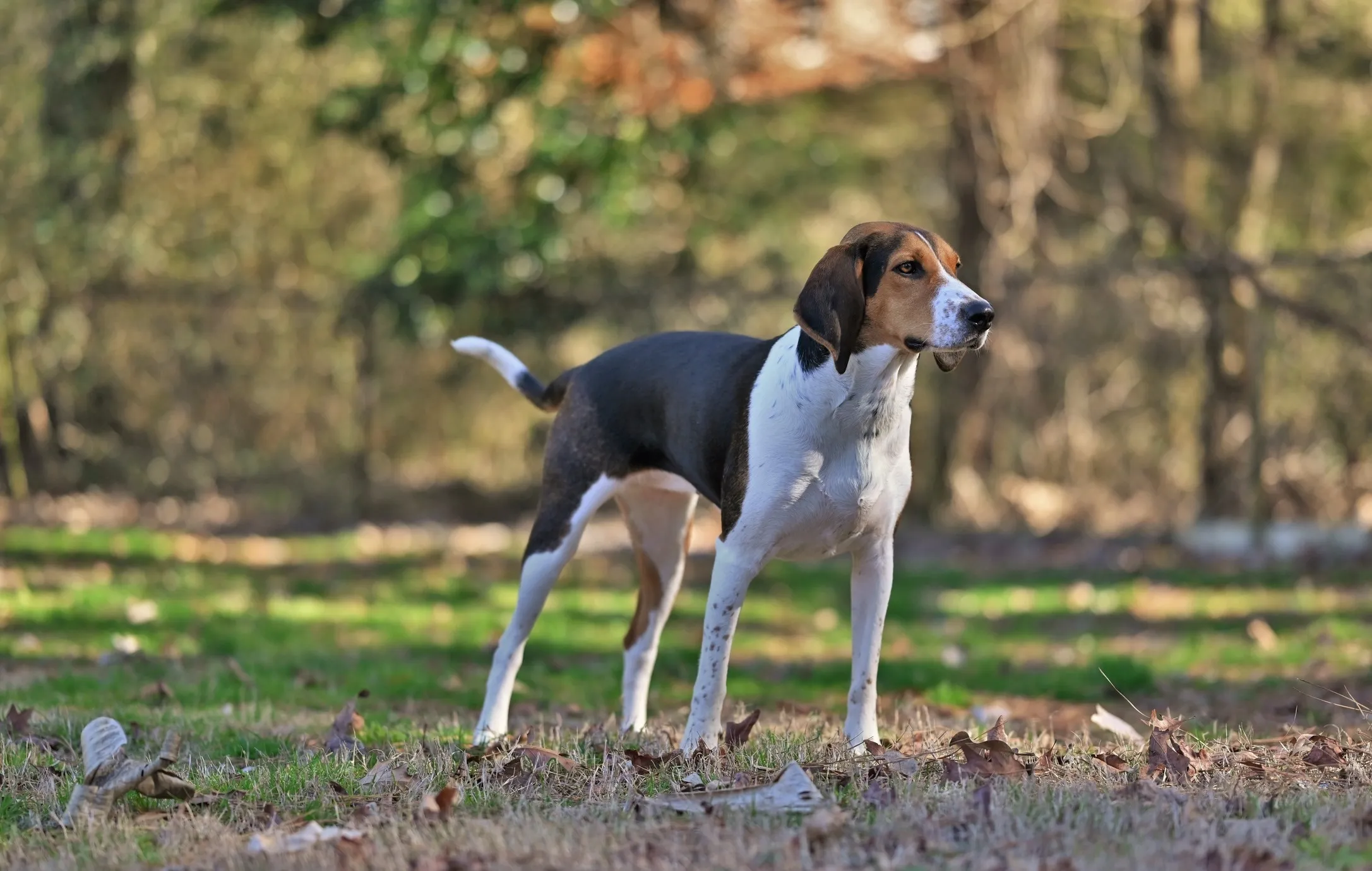 Treeing Walker Coonhound in a field
Treeing Walker Coonhound in a field
The Treeing Walker Coonhound is a quintessential American hound, instantly recognizable by its striking black, white, and tan tricolor coat, where black and white typically dominate. These dogs possess a classic hound appearance with long, drooping ears and expressive, dark eyes. Bred primarily for hunting raccoons and other small game, their name comes from their distinctive habit of “treeing” prey, cornering it up a tree until their handler arrives.
Known for their boundless energy and tenacious hunting drive, Treeing Walker Coonhounds are not dogs for the faint of heart. They require significant daily exercise, often enjoying long runs, hikes, or extensive playtime in a securely fenced yard. Without proper outlets for their energy, they can become bored and destructive. Despite their intensity on the trail, at home, they are often described as friendly, outgoing, and affectionate companions. They thrive in active families who can provide both mental and physical stimulation, along with plenty of love. Their intelligent and eager-to-please nature makes them trainable, though their strong prey drive means off-leash adventures need to be in very secure areas. For those looking to find a Walker Coonhound for sale, be prepared for a dog with a big personality and even bigger energy levels.
Black and Tan Coonhound
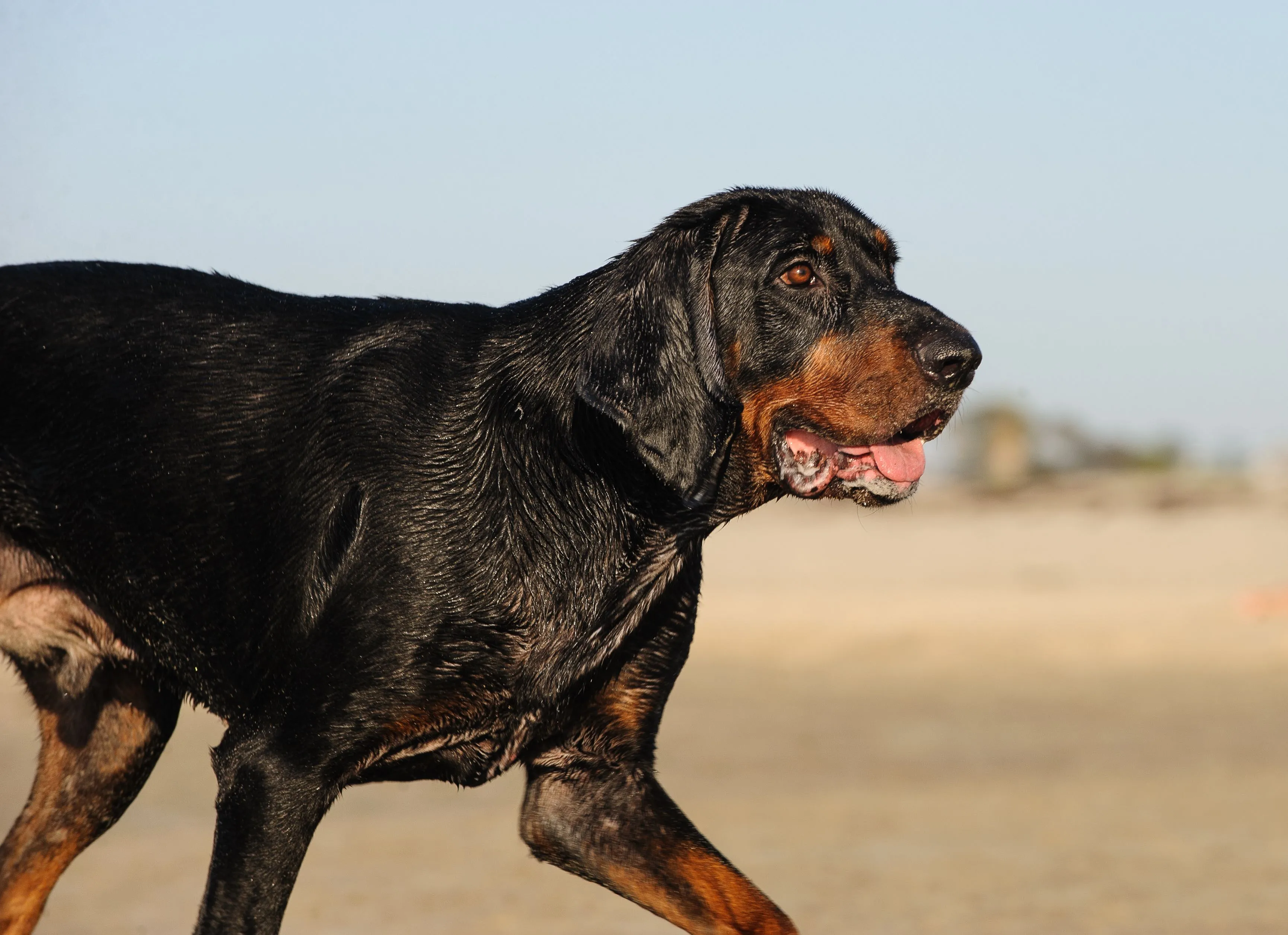 Wet Black and Tan Coonhound walking on a beach
Wet Black and Tan Coonhound walking on a beach
As their name clearly suggests, Black and Tan Coonhounds are defined by their handsome, deep black coats with rich tan markings. While not strictly “black and white,” the contrast between the dark black and the lighter tan points (often on their muzzle, chest, legs, and above the eyes) gives them a dramatic and often striking appearance that is appreciated by those who love strongly contrasted coats. These large, powerful scent hounds possess an exceptional sense of smell, making them outstanding trackers.
Originally bred in the United States to track raccoons and bears, the Black and Tan Coonhound is a resilient and determined hunter. Their remarkable nose means they excel in scent work and are happiest when they can put their tracking abilities to use, whether through formal scent training, long exploratory walks, or engaging in simulated hunts. At home, they tend to be mellow and affectionate, enjoying cuddles on the couch after a good workout. Their easygoing nature with family members, combined with their striking appearance, makes them a compelling choice. However, prospective owners should be ready for their distinctive baying howl and their need for consistent training and socialization to manage their powerful tracking instincts.
Bluetick Coonhound
The Bluetick Coonhound is arguably one of the most distinctly “black and white” hound breeds, known for its unique “bluish” ticking pattern. Their coat is predominantly white, heavily speckled with black spots, giving it a mottled, “blue” appearance. Often, they also have black patches on their ears and body, along with tan markings above the eyes and on their muzzle and legs, creating a captivating tri-color effect that is primarily black and white.
These intelligent and sociable hounds are always ready for an adventure. Like their coonhound relatives, Blueticks were bred for hunting and possess an incredible sense of smell and a loud, carrying bay. This vocalization is excellent for hunters but can be a challenge for apartment dwellers. Bluetick Coonhounds thrive on companionship and activity. They are energetic dogs that need ample exercise and mental stimulation to prevent boredom. Training and early socialization are important to channel their strong instincts productively. With their striking looks and lively personalities, Blueticks make devoted companions for active individuals or families who appreciate a dog with purpose and a penchant for exploration.
American English Coonhound
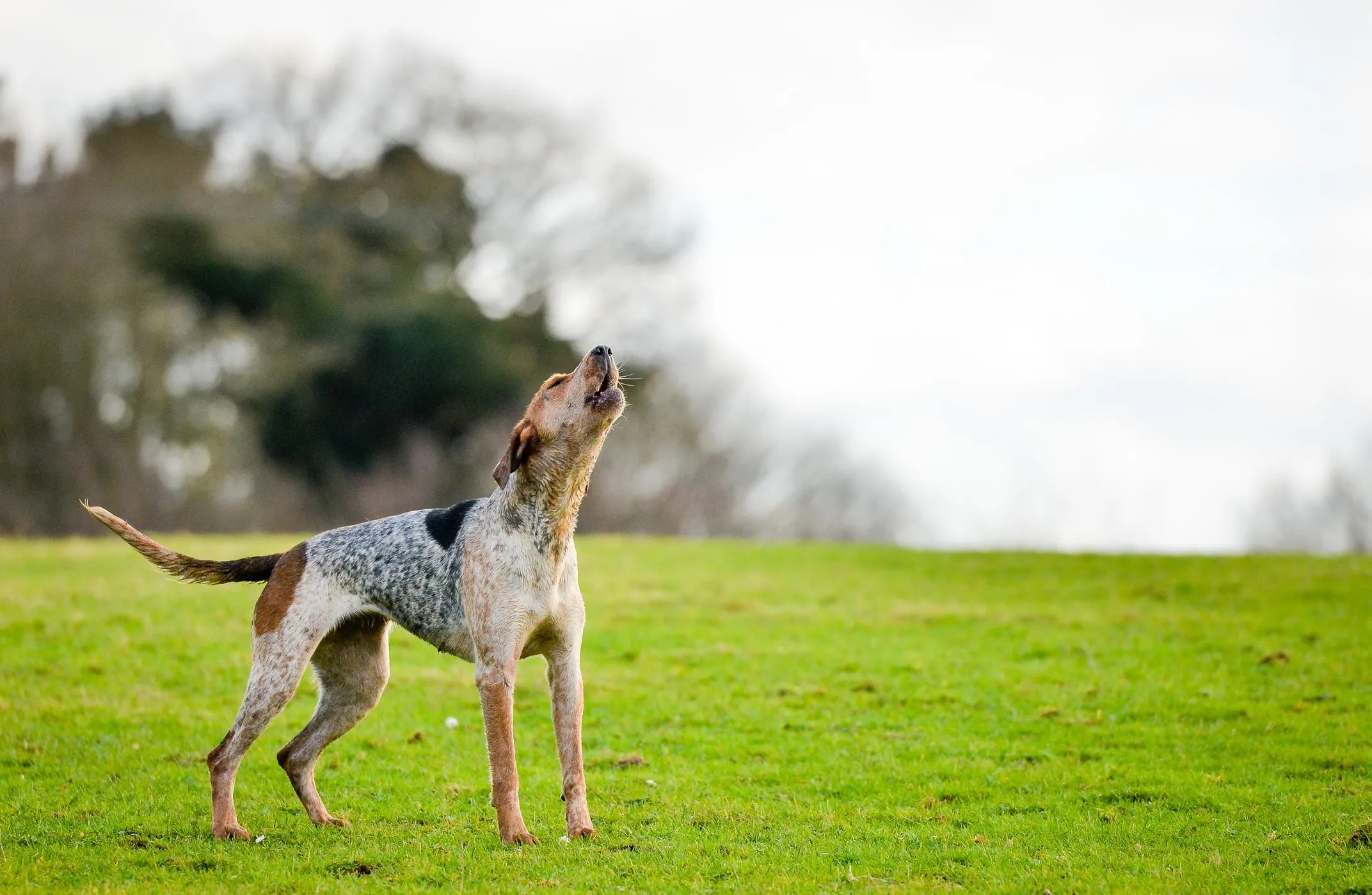 American English Coonhound howling
American English Coonhound howling
While the American English Coonhound is famously known as the “Redtick Coonhound” due to its common red and white ticking, it also comes in other distinctive patterns, including tricolor (black, white, and tan) and blue ticked variations, which feature prominent black and white markings. These elegant dogs are streamlined and powerful, built for endurance and speed over long distances.
Originally bred for hunting fox by night and raccoons by day, American English Coonhounds are celebrated for their exceptional tracking skills and incredible stamina. They are highly social dogs that thrive in family environments, provided their significant exercise needs are met. A fenced yard for exploration and regular opportunities for long walks or runs are essential to keep them happy and healthy. Their distinctive baying sound, while a valuable tool for hunters, is a characteristic trait that owners should be prepared for. When not on the trail, their affectionate and easygoing nature makes them wonderful companions, eager to be part of family activities. Their intelligence also makes them highly trainable, though their independent spirit means consistency is key.
Basset Hound
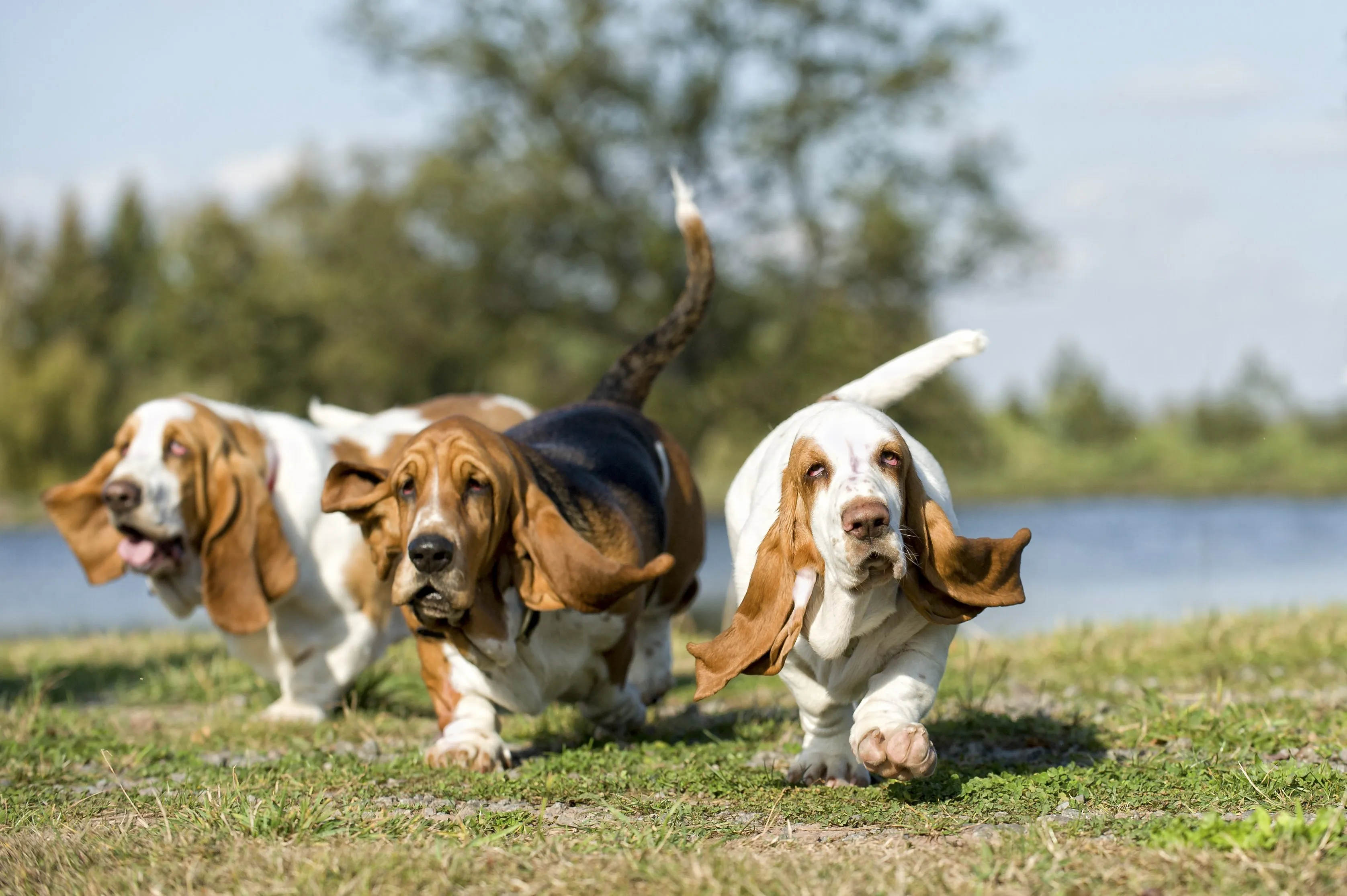 Group of Basset Hounds running across a yard
Group of Basset Hounds running across a yard
The Basset Hound, with its iconic long, droopy ears, wrinkled brow, and soulful eyes, is a gentle giant in a low-slung body. While often tricolor (black, white, and tan), their coat patterns frequently feature large, distinct black patches on a white background, making them appear strongly black and white with tan accents. The word “basset” is French for “rather low,” perfectly describing their unique physique.
Bred for hunting small game like rabbits and hare, Basset Hounds possess an extraordinary sense of smell, second only to the Bloodhound. Despite their low-key appearance and reputation for being lazy, they are still scent hounds at heart and love to follow a trail. Regular, moderate exercise is important, including scent walks where they can engage their powerful noses. Indoors, they are beloved for their calm, friendly, and affectionate temperament, making them excellent family pets. They are generally good with children and other animals. However, their independent nature and stubborn streak can make training a challenge, requiring patience and positive reinforcement. Their long ears require regular cleaning to prevent infections, and owners should be aware of potential back issues due to their elongated spine. For those interested in dogs that look like Basset Hounds, it’s their unique blend of charm and placid demeanor that truly sets them apart.
Beagle
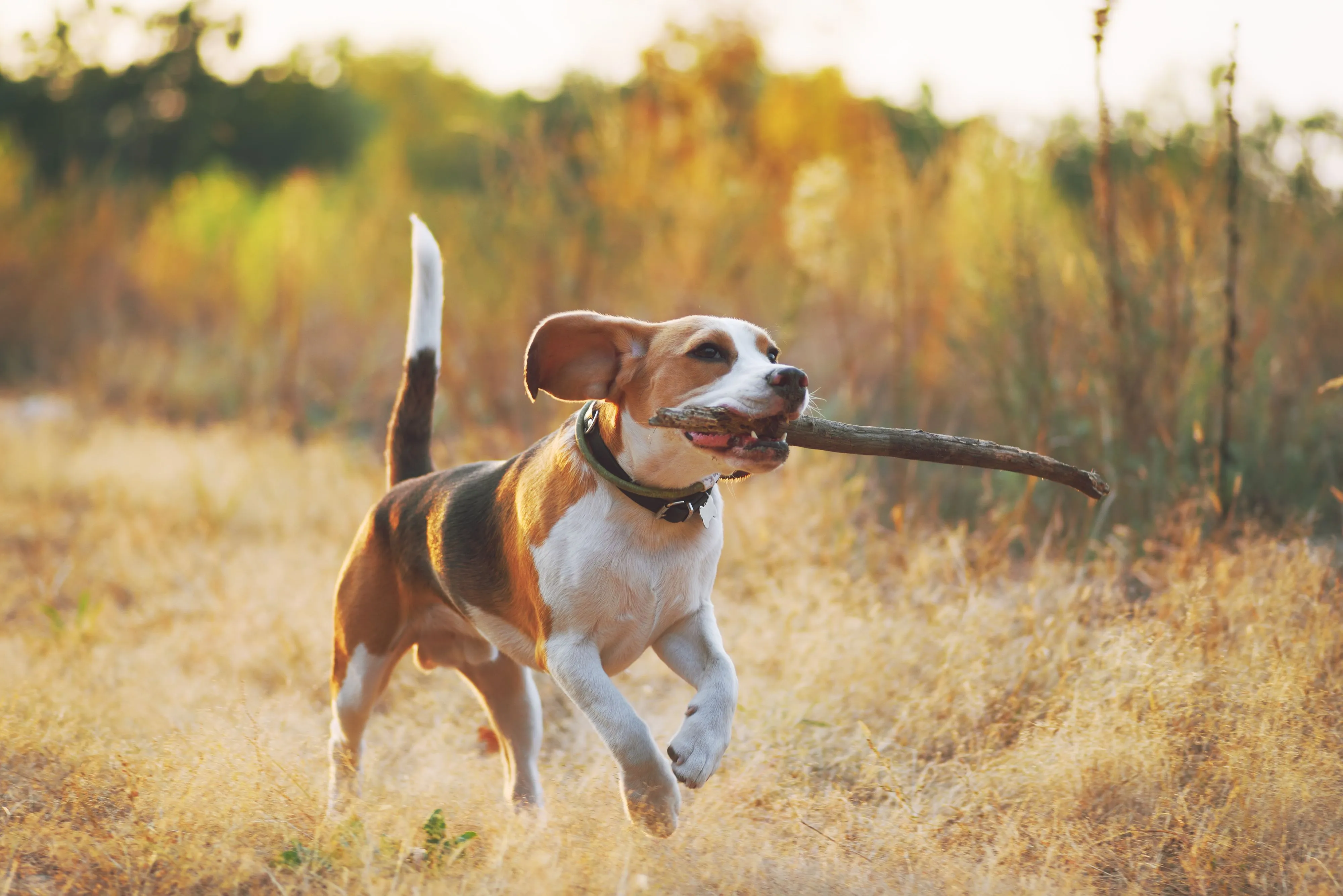 Beagle running with a stick in his mouth
Beagle running with a stick in his mouth
The Beagle, one of the most popular hound breeds, typically sports a tricolor coat of black, white, and tan, with white covering their chest, belly, legs, and tail tip, and a black saddle often dominating their back, creating a clear black and white visual. Their compact size, friendly demeanor, and infectious playfulness make them highly appealing.
Beagles were originally bred as hunting dogs, prized for their keen sense of smell and incredible stamina in tracking rabbits and hares. This strong scent drive means they love to explore and need plenty of opportunities for exercise and mental stimulation. Daily walks, playtime, and engaging their nose with scent games are crucial to their well-being. Despite their hunting prowess, Beagles are known for their sweet, gentle, and happy-go-lucky personalities, making them wonderful family pets. They thrive on companionship and do best in homes where they receive plenty of attention. Their characteristic “baying” howl is a trait that owners should be prepared for. With proper training and socialization, Beagles are loyal and adaptable companions, though their mischievous streak means a good sense of humor is always a plus.
Greyhound
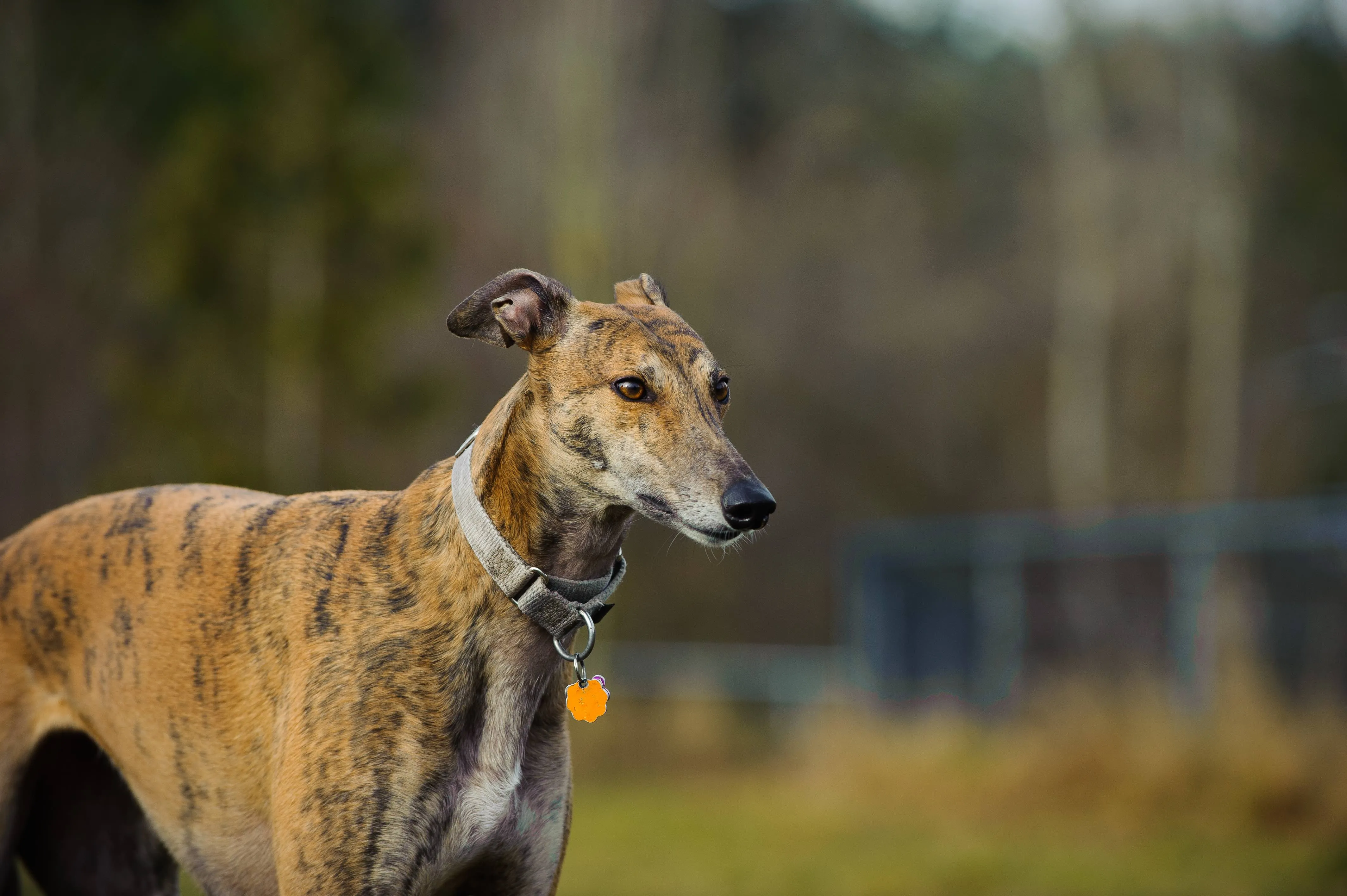 Brindle Greyhound standing
Brindle Greyhound standing
The Greyhound is the epitome of speed and grace, renowned for its slender, muscular build and elegant appearance. While often seen in fawn, brindle, or solid colors, Greyhounds can also have striking black and white coats, either solid black with white markings or white with black patches (parti-color). Their short, smooth coat highlights their athletic physique.
Historically bred for hunting and racing, Greyhounds are the fastest dog breed in the world, capable of reaching speeds up to 45 miles per hour. Despite this incredible athletic ability, they are often lovingly referred to as “45-mph couch potatoes” due to their calm, gentle, and laid-back demeanor indoors. They require regular opportunities for short, intense bursts of exercise, such as sprinting in a securely fenced area, but are perfectly content to relax and cuddle on the sofa for much of the day. Their quiet, sensitive nature makes them excellent companions for many types of households, including those with respectful children and other pets. Grooming needs are minimal due to their short coat. Greyhounds form strong bonds with their families and are known for their quiet loyalty and affectionate disposition, making them surprisingly adaptable pets for those seeking a tranquil yet active companion.
Whippet
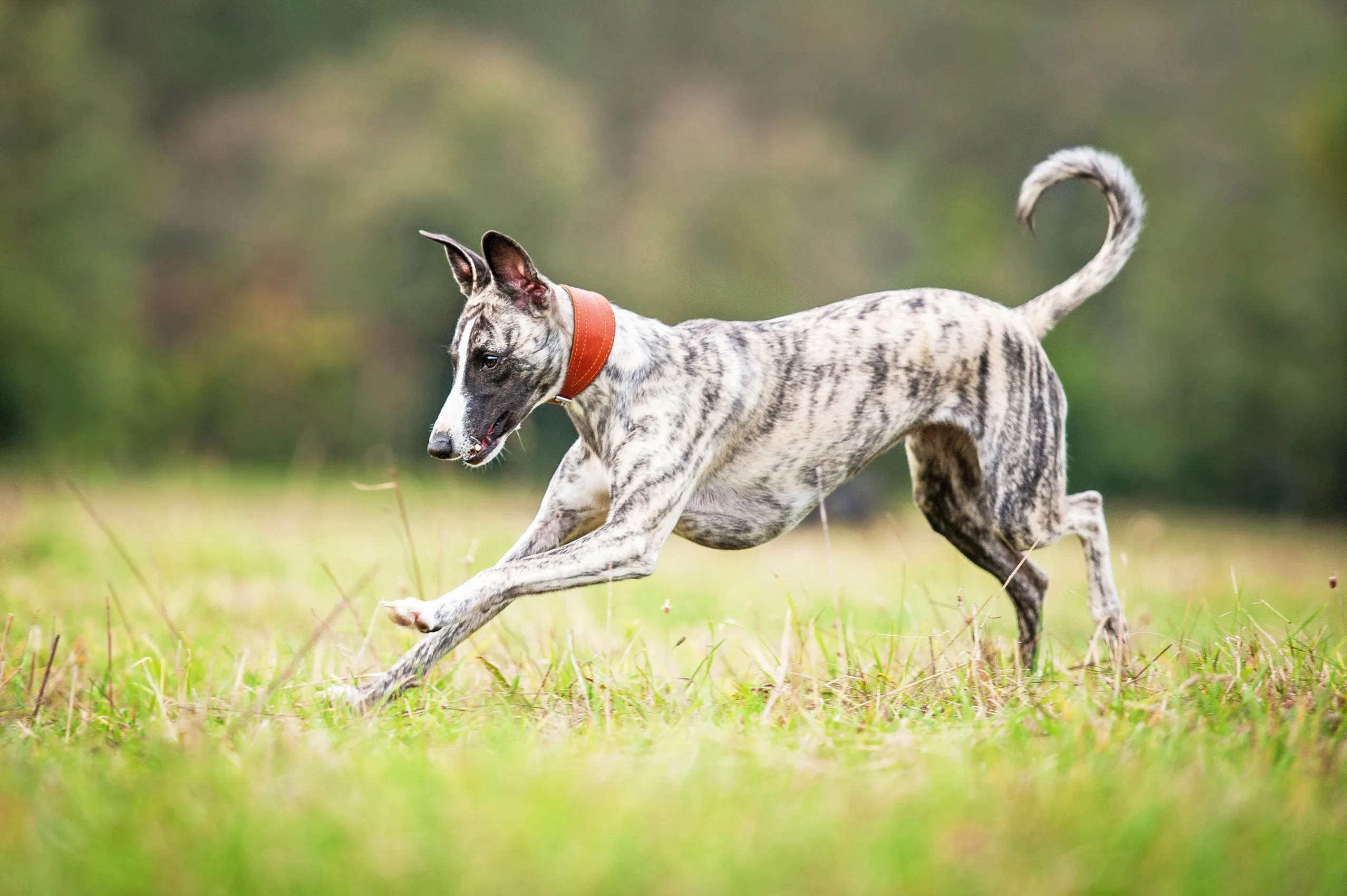 White and gray brindle Whippet pouncing in a field
White and gray brindle Whippet pouncing in a field
The Whippet, often described as a “poor man’s Greyhound,” shares many of its larger cousin’s elegant traits but in a more compact package. Whippets boast a sleek, aerodynamic build and can be found in a wide array of colors and patterns, including stunning black and white combinations, either solid black with white markings or white with black patches. Their short, fine coat emphasizes their athletic form.
Bred for racing and lure coursing, Whippets are incredibly fast and agile, capable of reaching speeds up to 35 miles per hour. Like Greyhounds, they are sighthounds with a strong prey drive, so a securely fenced yard is essential for safe off-leash play. Despite their speed, Whippets are incredibly adaptable and make fantastic family pets. Indoors, they are typically quiet, gentle, and affectionate, often curling up on the sofa with their human companions. They are often referred to as “velcro dogs” due to their desire to be close to their people. Their moderate exercise needs include daily walks and opportunities to sprint, which helps keep them physically and mentally healthy. Whippets are generally good with children and other pets, and their minimal grooming requirements make them a relatively low-maintenance breed for owners seeking a graceful yet loving companion.
Dachshund
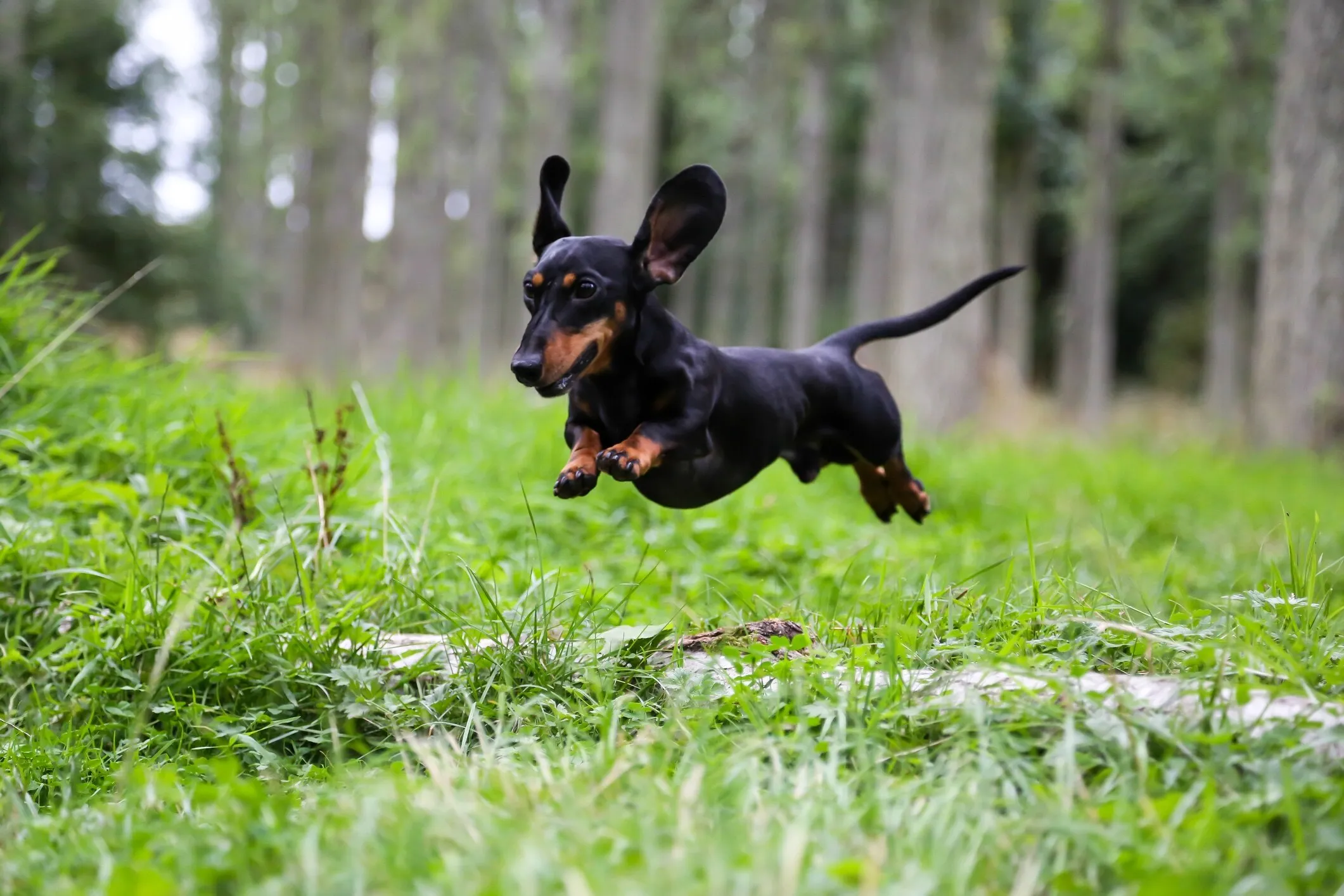 Tricolor Dachshund zooming across grass
Tricolor Dachshund zooming across grass
Dachshunds, affectionately known as “weiner dogs,” are distinctive with their long bodies, short legs, and bold personalities. While often associated with red or black and tan coats, Dachshunds also come in a variety of patterns that include strong black and white elements, such as black and cream dapples, piebald (white with large patches of black), or solid black with white markings. These patterns can appear in all three coat types: smooth, wirehaired, and longhaired.
Originally bred in Germany to hunt badgers and other burrowing animals, Dachshunds are fearless, persistent, and possess a surprisingly loud bark for their size. Their independent and curious demeanor, combined with their playful nature, makes them delightful companions. Despite their small stature, they are energetic dogs that require regular exercise to maintain a healthy weight and strong back, which is crucial given their unique body shape. Short, brisk walks and supervised playtime are usually sufficient. Dachshunds form strong bonds with their families and can be very affectionate, though they may be reserved around strangers. Training can be a fun challenge due to their independent streak, but they are intelligent and respond well to consistent, positive reinforcement. Their grooming needs vary by coat type, with wirehaired and longhaired varieties requiring more attention.
Harrier
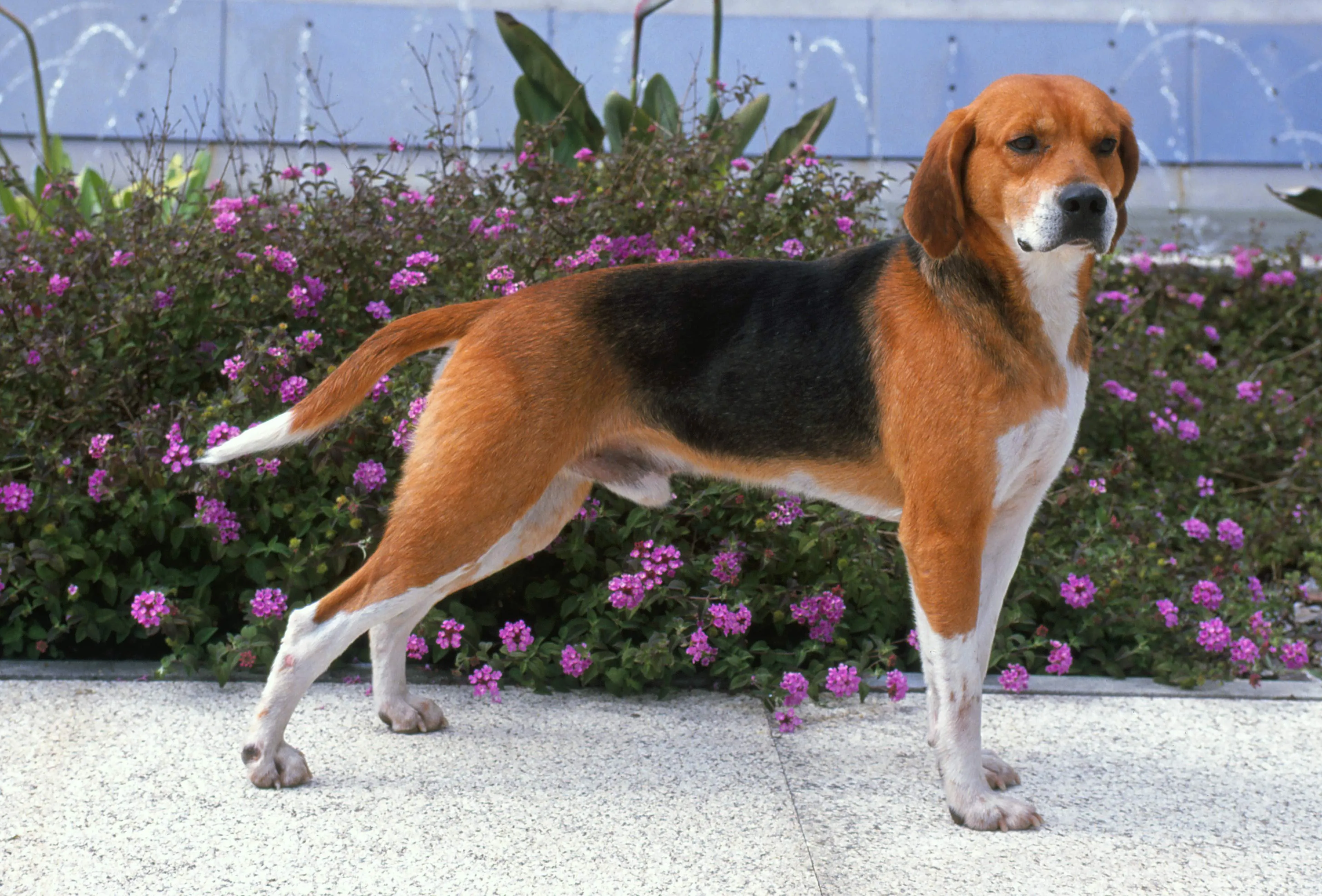 Harrier dog standing on sidewalk
Harrier dog standing on sidewalk
The Harrier is a medium-sized hound that often resembles a larger Beagle or a smaller English Foxhound, and commonly exhibits a tricolor coat of black, white, and tan. The white typically covers the chest, belly, and legs, with black forming a prominent saddle on the back and tan markings adding accents to the head and sometimes legs. This pattern makes them a clear contender among black and white hound breeds.
Harriers were bred in medieval England to hunt hare, hence their name. These energetic pups are known for their keen sense of smell, stamina, and playful nature. As pack animals, they tend to thrive in the company of other dogs and are generally sociable with people. Their high energy levels mean they need plenty of exercise to prevent boredom and channel their exuberance into positive activities. Daily long walks, runs, or vigorous play sessions are essential. Harriers are intelligent and trainable, but their strong prey drive and independent hound nature require consistent training and a securely fenced yard. With a Harrier, you get a robust, friendly, and tireless companion who loves to be active outdoors and then settle in for a relaxed evening with their family.
English Foxhound
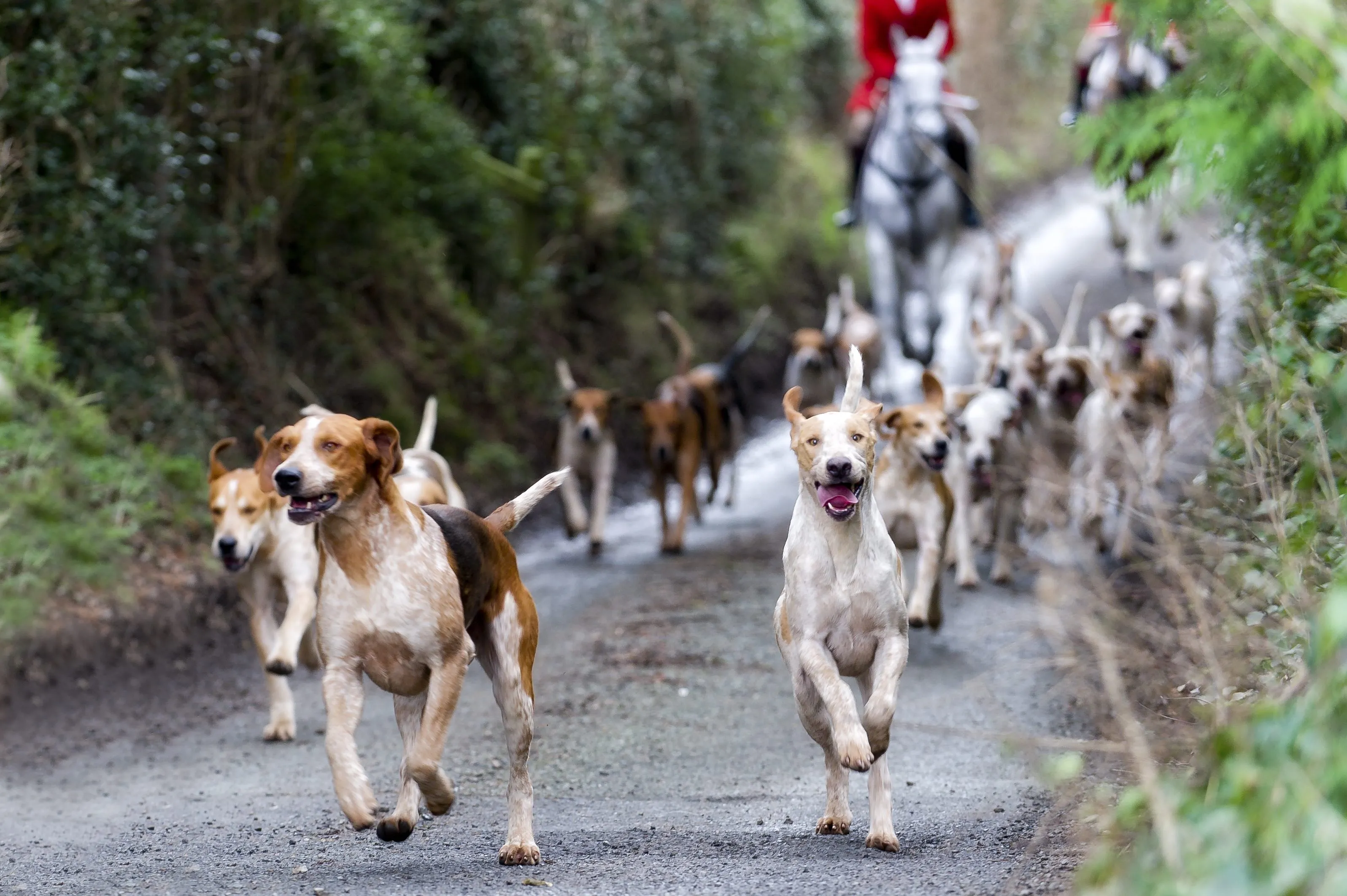 Group of English Foxhounds running on a hunt
Group of English Foxhounds running on a hunt
The English Foxhound is a robust and powerful scent hound, built for stamina and speed over long hunts. While they come in a variety of hound colors, the most common pattern is tricolor (black, white, and tan), with large patches of black on a white background and tan markings, making their black and white presence undeniable. Their short, dense coat is weather-resistant and relatively low-maintenance.
Bred specifically for fox hunting in England, the English Foxhound is a dedicated and determined hunter with an incredibly strong prey drive. These are sociable dogs that were traditionally bred to work in large packs, so they generally thrive in the company of other dogs and people. Due to their history as working dogs, they have immense energy and require significant daily exercise to maintain their physical and mental well-being. Long runs, hikes, or activities that engage their powerful nose are ideal. While friendly and generally good-natured, their strong hunting instincts and need for constant activity mean they are best suited for experienced owners who can provide ample opportunities for outdoor adventure and consistent training. They form strong bonds with their families and are a magnificent sight, especially when on the move.
American Foxhound
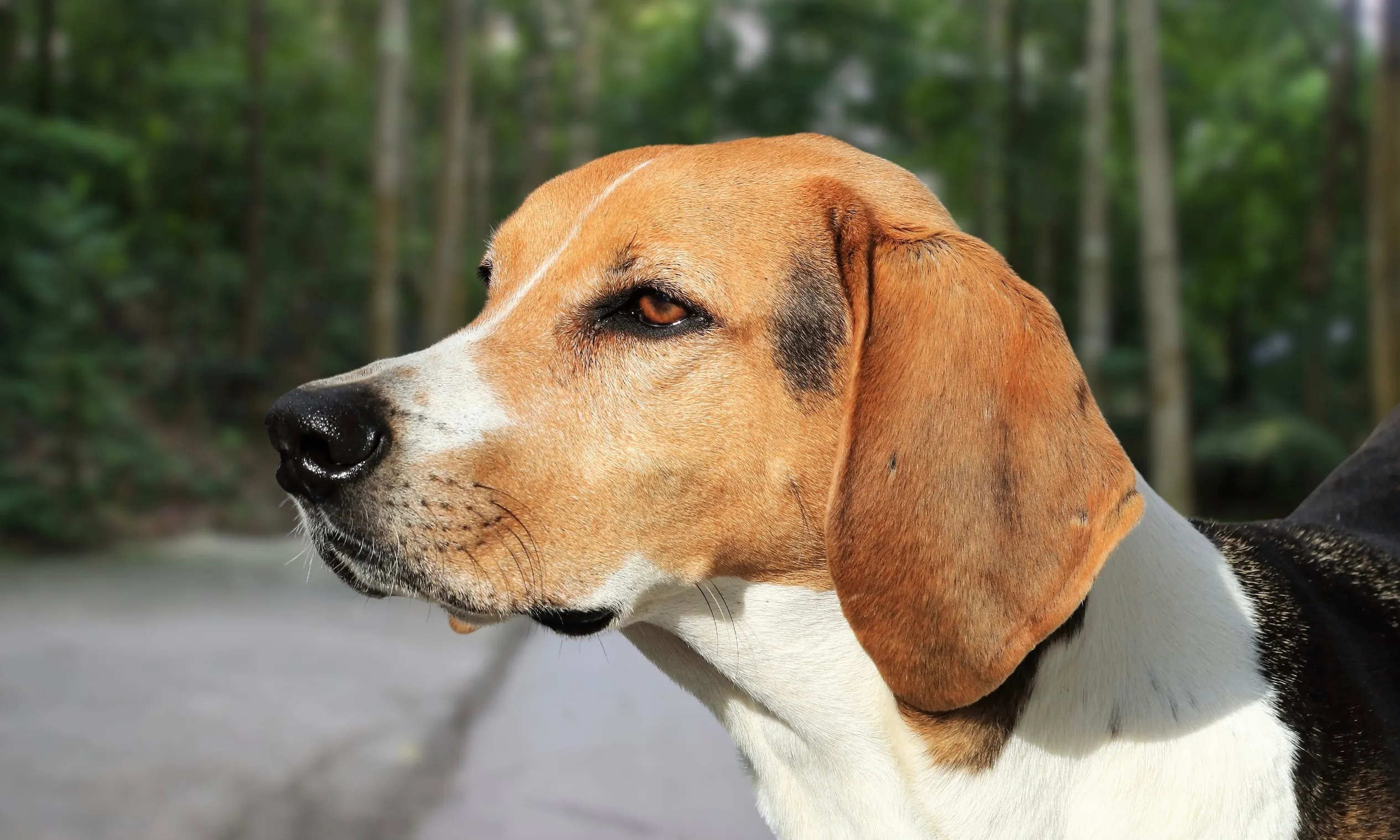 Close-up of an American Foxhound
Close-up of an American Foxhound
The American Foxhound, a close cousin to its English counterpart, shares a similar dignified and athletic appearance. Like the English Foxhound, they typically sport a tricolor coat of black, white, and tan, with the black and white portions being very prominent and defining their classic hound look. Their short, hard coat is designed for durability in the field.
Developed in the United States from English Foxhounds, this breed was refined for hunting foxes across the varied American terrain. American Foxhounds are renowned for their exceptional endurance, determination, and melodious baying voice, which can carry for miles. These dogs are ideal for individuals or families who lead a highly active lifestyle and can keep up with their boundless energy. They need plenty of opportunities to sniff, explore, and stretch their legs in a securely fenced yard or on long, vigorous walks and runs. Their friendly and gentle disposition makes them good family dogs, though their strong hunting instincts mean they are often focused on scent when outdoors. While adaptable, they are happiest when they have a purpose and plenty of physical and mental stimulation. Consistent training and early socialization are important to manage their independent spirit and ensure they become well-adjusted companions.
Conclusion
Black and white hound dog breeds offer a captivating blend of striking aesthetics and impressive capabilities. From the tenacious Treeing Walker Coonhound to the serene Greyhound, each breed brings its own unique set of traits, but all share the hound’s characteristic nose for adventure and a deep-seated loyalty to their human companions. These dogs thrive in environments where their innate instincts are understood and catered to, be it through extensive exercise, scent work, or simply a deep bond with an active family.
Choosing one of these magnificent black and white hounds means committing to a life of activity, engagement, and companionship. Their sharp contrasts in color are often matched by their dual nature: driven hunters in the field and loving, often laid-back, companions at home. Before welcoming one into your life, always consider their exercise requirements, grooming needs, and general temperament to ensure a harmonious match. Consulting with a local veterinarian or a veterinary behaviorist can provide invaluable insights into a dog’s energy level and personality, helping you make the best decision for your family and your future canine friend.
